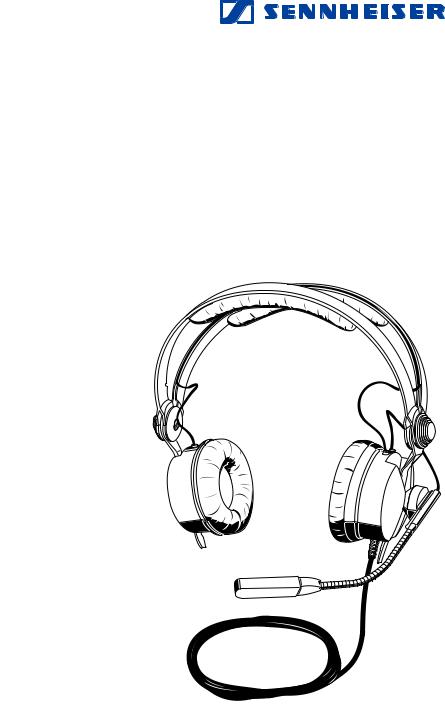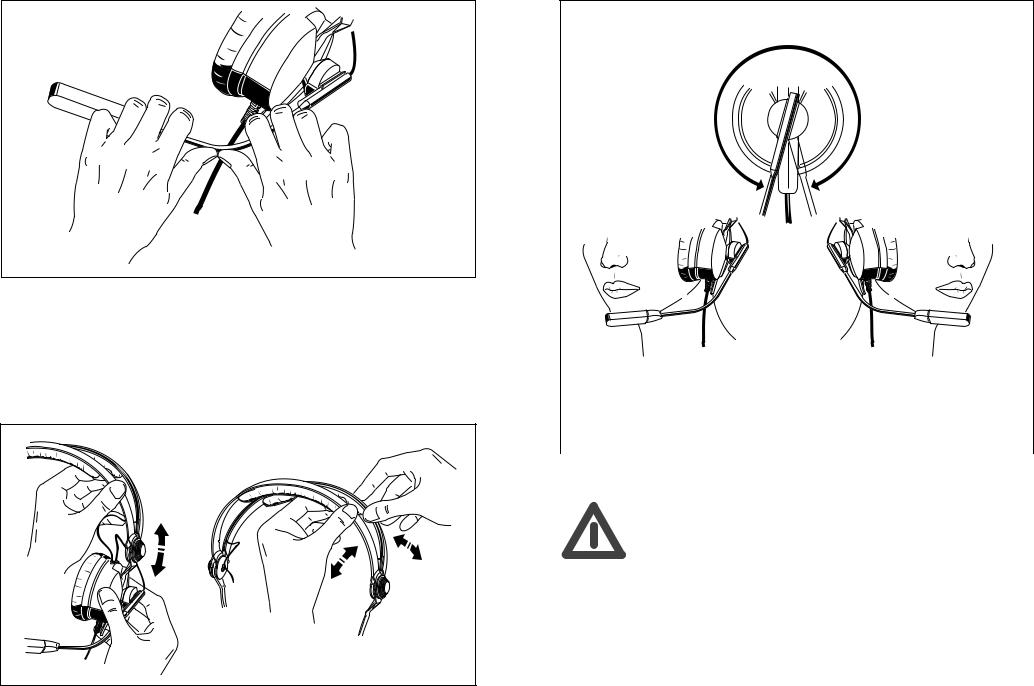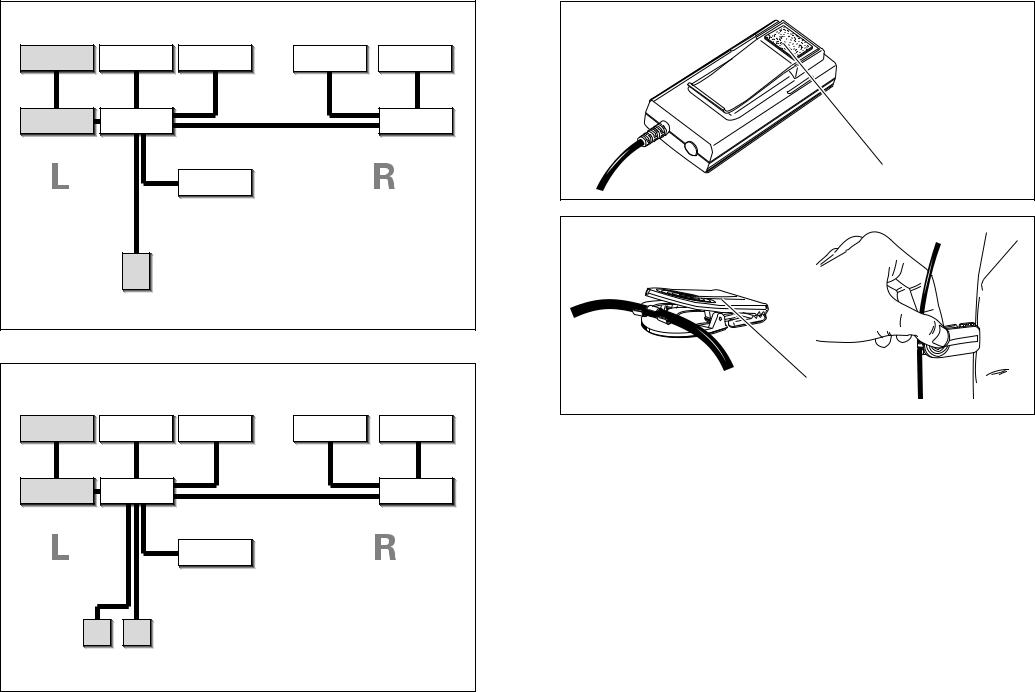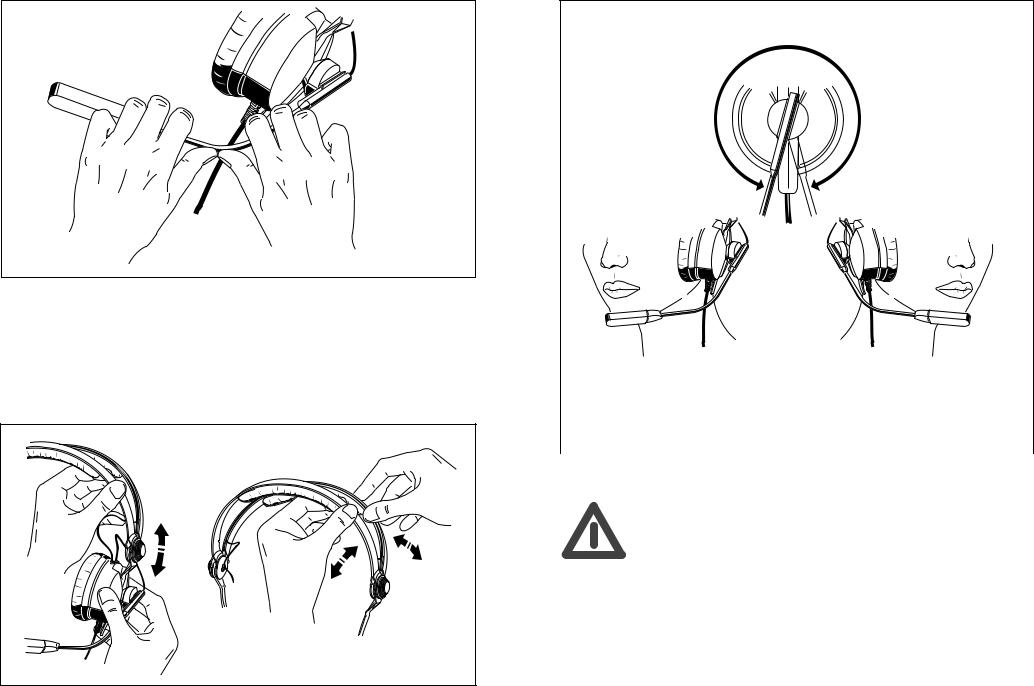Sennheiser HMEC 25-CA User Manual 2

Gebrauchsanleitung Instructions for use Notice d‘emploi Istruzioni per l‘uso Instrucciones para el uso Gebruiksaanwijzing
HMEC 25-CA
P/N 025-230-125
HMEC 25-KA
P/N 025-230-115




 ™
™

Gebrauchsanleitung ............................................................................................... |
3 |
Instructions for use .............................................................................................. |
11 |
Notice d´emploi .................................................................................................... |
19 |
Istruzioni per l´uso ............................................................................................... |
27 |
Instrucciones para el uso ..................................................................................... |
35 |
Gebruiksaanwijzing .............................................................................................. |
43 |
Lärm - wo begegnet er uns nicht?
Ob am Arbeitsplatz, in der häuslichen Umgebung, in öffentlichen Verkehrsmitteln, auf Flug-, Bahnoder Busreisen - eigentlich begleitet er uns überall.
Die negativen Auswirkungen dieser Lärmbelästigungen sind durch Studien belegt und auch jeder von uns wird sie schon gespürt haben:
Nervosität
Konzentrationsmangel
Gereiztheit ...
sind nur die augenscheinlichen Auswirkungen auf den Organismus. Lärm wirkt zudem auf das vegetative Nervensystem und kann zu Dauerschäden des Gehörs führen.
Die Quellen des Lärms sind vielfältig und nur zu oft für den einzelnen nicht abzustellen. Daher kann nur der persönliche Schutz an einem lärmerfüllten Ort eine Lösung darstellen.
Mit dem System NoiseGard™ hat Sennheiser eine wirkungsvolle Lösung realisiert. Das Funktionsprinzip und die Bedienung wird Ihnen in dieser Anleitung erläutert.
Schallpegel von Lärmquellen
|
140 dB |
Düsentriebwerk (25m Entfernung) |
Laut |
130 dB |
Flugzeugmotor |
120 dB |
Druckluftbohrer |
|
|
110 dB |
Schmiedehammer, Betonwerk |
|
100 dB |
Metalldruckgußmaschine |
|
|
|
|
90 dB |
Metallwerkstatt |
|
80 dB |
Traktor |
|
|
|
|
70 dB |
Büro |
|
60 dB |
Unterhaltung |
|
|
|
|
50 dB |
Umweltlärm |
|
40 dB |
Wohnraum |
|
|
|
Leise |
30 dB |
Bibliothek |
20 dB |
Schlafzimmer |
|
|
10 dB |
Wald, windstill |
Die Maßeinheit für Schallpegel ist das Dezibel (dB). Eine Lärmdämpfung um 10 dB wird allgemein als Halbierung der Lautstärke empfunden, weitere 10 dB Dämpfung ergeben eine um 75% reduzierte Lärmempfindung u.s.w.
2 |
3 |

HMEC 25-CA / HMEC 25-KA
Eine Hör-/ Sprech-Garnitur faßt zwei Baugruppen, Kopfhörer und Mikrofon zu einer Funktionseinheit zusammen. Überwiegender Einsatzbereich dieser Hör-/ Sprech-Garnituren HMEC 25-KA/-CA ist die Kommunikation im Flugzeugcockpit.
Als Mikrofon wird ein hochwertiges dauerpolarisiertes Elektretmikofon benutzt. Die notwendige Versorgungsspannung wird ( gemäß ARINC) über den Anschlußstecker aus dem Bordnetz des Flugzeuges bezogen.
Als Kopfhörer dienen Sennheiser NoiseGard™-Systeme. Dies sind dynamische Hörersysteme, bei denen, zusätzlich zur Wiedergabe eines Audiosignales, auf elektronischem Weg tieffrequenter Störschall kompensiert wird. Die aktive
Lärmkompensation funktioniert nach dem physikalischen Prinzip, daß sich Schall und "Antischall" (um 180° phasenverschoben) gegenseitig auslöschen. Die NoiseGard™-Kompensationselektronik im Kopfhörer benötigt eine gesonderte eigene Stromversorgung, die das fest mit dem Kabel verbundene Speiseteil (Siehe Abbildung rechts) liefert.
Ungestörte Verständigung wird möglich, ohne die Lautstärke so laut einstellen zu müssen, daß die Umweltgeräusche übertönt werden.
NoiseGard™ erhöht den Komfort,
ist aber kein medizinischer Hörschutz !
Geräuschkompensation mit NoiseGard™
Noise compensation HMEC 25
Reduction/dB
0
10 |
|
|
active |
passive |
|
|
||||
20 |
|
|
|
|
|
|
||||
|
|
|
|
|
|
|
|
|
|
|
|
|
|
|
|
|
|
|
|
|
|
30 |
|
|
|
|
|
|
|
|
|
|
|
|
|
|
|
|
|
|
|
|
|
40 |
|
|
|
|
|
|
|
|
|
|
|
|
|
|
|
|
|
|
|
|
|
20 |
100 |
1000 |
10000 |
20000 |
||||||
|
|
|
|
|
|
|
Frequency/Hz |
|||
Einlegen der Batterien im Speiseteil
Die Kompensationselektronik NoiseGard™ wird durch eine Batteriebox im Kabel der Hör-/ Sprech-Garnitur mit Strom versorgt. Legen Sie zwei Batterien in die Batteriebox ein.
EIN- / Ausschalten
Der EIN/AUS-Schalter für die Stromversorgung der Kompensationselektronik befindet sich an der Vorderseite der Batteriebox.
Kontroll-LED
Die LED auf der Batteriebox informiert Sie über den Batteriezustand:
Leuchtet die LED grün, wird die Kompensationselektronik ausreichend mit Strom versorgt.
Leuchtet die LED rot, sind die Batterien fast erschöpft und müssen jetzt getauscht werden. Noch ist NoiseGard™ in Funktion.
Bleibt die LED nach dem Einschalten dunkel, sind die Batterien vollkommen erschöpft, die Hör-/ Sprech-Garnitur bleibt weiter einsatzbereit, aber ohne Lärmkompensation.
Das Mikrofon ist durch die eigene Spannungsversorgung aus dem Bordnetz des Flugzeuges unabhängig von den Batterien und bleibt immer in Funktion.
EIN/AUS
LED
4 |
5 |

Mikrofonarm einstellen |
Kabel (rechts oder links) |
Hinweis: Der Mikrofonarm kann durch Biegen individuell angepaßt werden. Diese Einstellung sollte möglichst nicht ständig geändert werden, bei sehr häufigem Hinund Herbiegen kann der Arm brechen!
Kopfbügel einstellen
6
350°
Kabel links |
Kabel rechts |
|
|
HINWEISE |
NoiseGard™ dient der Geräuschverminde- |
|
rung zur Erhöhung des Komforts. |
|
NoiseGard™ ist kein medizinisches |
|
Lärmschutzsystem! |
|
NoiseGard™ ersetzt kein industrielles |
|
Lärmschutzsystem zum Einsatz in |
|
lärmerfüllter Umgebung! |
Laut hören ? - NEIN !
Mit einem Kopfhörer wird gern lauter als mit Lautsprechern gehört. Hohe Lautstärke, die über längere Zeit auf Ihre Ohren einwirkt, kann zu dauerhaften Hörschäden führen. Schützen Sie Ihr gesundes Gehör, Sennheiser-Kopfhörer klingen auch bei niedriger Lautstärke besonders gut ...
7

Blockschaltbild HMEC 25 CA
boom |
headphone |
microphone |
capsule (left) |
microphone |
compensation |
amplifier |
circuit (left) |
compensation |
microphone (left) |
battery |
box |
compensation microphone (right)
headphone capsule (right)
compensation circuit (right)
5-pin XLR plug
Blockschaltbild HMEC 25 KA
boom |
headphone |
microphone |
capsule (left) |
microphone |
compensation |
amplifier |
circuit (left) |
compensation |
microphone (left) |
battery |
box |
compensation microphone (right)
headphone capsule (right)
compensation circuit (right)
3-pin 3-pin plug plug
Klettband (selbstklebend)
MZQ 2002-1
Lieferumfang
1 HMEC 25-KA oder HMEC 25-CA 1 Schutzund Transporttasche
1 Windschirm MZW 45 (Art.Nr. 75823)
1 Klettband (selbstklebend), Abb.
1 Klemmhalter MZQ 2002-1 (Art.Nr. 44740), Abb.
8 |
9 |

Technische Daten
Wandlerprinzip Übertragungsbereich Impedanz aktiv/passive
Klirrfaktor Lärmdämpfung aktiv Frequenzbereich der aktiven Lärmdämpfung
Wandlerprinzip
Übertragungsbereich bei einem Abstand von 2 cm zum Mundwinkel
max. Schalldruckpegel Ausgangsspannung
Abschlußwiderstand
Versorgungsspannung
Kopfhörer-Andruckkraft Gewicht ohne Kabel Kabel
Stecker
HMEC25-CA:
Stromversorgung
Betriebszeit
Anzeige:
NoiseGard™ HMEC 25-KA / -CA
Kopfhörer
dynamisch, geschlossen, ohraufliegend 16 Hz - 22 kHz
200 Ohm (mono) 400 Ohm pro Seite (stereo) Lautstärke aktiv und passiv gleich
< 1 %
15 dB + 3 dB im Bereich von 100 Hz - 2 kHz
50 - 600 Hz
Mikrofon incl. Vorverstärker
Back-Elektret-Kondensatorkapsel, geräuschkompensiert
300 Hz - 5 kHz entsprechend DO-214
120 dB (Klirrfaktor 1 %)
400 mV ± 3 dB bei 114 dB aus 6 mm Abstand (entsprechend DO-214)
150 Ohm
8 - 16 V DC, ca 8 - 25 mA, Beschaltung nach RTCA/DO 214
Allgemeine Daten
ca 2,5 N 170 g
einseitig, Länge gesamt: 1,8 m
Stereo-Klinke 6,3 mm, mono beschaltet PJ-068, 5,25 mm Mikrofon
XLR-5
2 x 1,5 V Mignon (AA) Alkali-Mangan Batterien (2700 mAh)
ca. 20 h
Zweifarben-LED zur Batteriekontrolle
The Problem of Noise
The negative effects of noise pollution have been proven by studies, and everybody will have experienced them at some time or another:
Nervousness
Lack of concentration
Irritability
And these are only the most obvious effects on the human body. Noise also affects the autonomic nervous system and can lead to permanent hearing damage.
There are a multitude of noise sources, and the individual very often has no influence over them. The only solution when being in a noisy place is protecting oneself against ambient noise. These noise problems are particularly prevalent in an aircraft cockpit where a pilot often has to have the communications headset so loud as to risk permanent hearing damage.
With the NoiseGard™ system, Sennheiser has come up with an effective solution. These operating instructions explain the NoiseGard™ principle and show you how to use the NoiseGard™ headset.
Noise levels
|
140 dB |
Jet engine (at a distance of 25 m) |
loud |
130 dB |
Aircraft engine (This is the treshold of pain) |
120 dB |
Pneumatic drill |
|
|
110 dB |
Blacksmith's hammer, concrete works |
|
100 dB |
Die-cast machine |
|
|
|
|
90 dB |
Metal workshop |
|
80 dB |
Tractor |
|
70 dB |
Office |
|
60 dB |
Conversation |
|
|
|
|
50 dB |
Ambient noise |
|
40 dB |
Living room |
quiet |
30 dB |
Library |
20 dB |
Bedroom |
|
|
10 dB |
Forest, no wind |
The unit of sound levels is the decibel (dB). A noise reduction of 10 dB is generally perceived as a halving of the loudness, another 10 dB decrease halves the loudness yet again whitch corresponds to a loudness reduction of 75 %, and so on.
10 |
11 |

HMEC 25-KA / HMEC 25-CA
A headset is comprised of two units, a headphone and a microphone. The HMEC 25-KA/-CA headset is mostly used for communication in aircraft cockpits.
The microphone is a high quality back-electret condenser microphone. As per ARINC it receives its operating voltage via a connector from the aircraft´s internal power supply.
The headphone is a Sennheiser NoiseGard™ system. This is a dynamic headphone system which, in addition to reproducing the original audio signal, electronically cancels the low frequencies of the ambient noise. This active noise compensation operates on the principle that sound and ”anti-sound“ (in phase opposition) cancel each other out. The NoiseGard™ compensation circuitry in the headphone requires an extra power supply, so a battery compartment has been integrated into the headset cable (see illustration on the right).
Clearly intelligible communication is ensured, and the pilot no longer has to turn the volume up to overcome ambient noise.
NoiseGard™ increases your comfort,
but it is not a medical hearing protection!
Active noise compensation with NoiseGard™
Noise compensation HMEC 25
Reduction/dB
0
10 |
|
|
active |
passive |
|
|
||||
20 |
|
|
|
|
|
|
||||
|
|
|
|
|
|
|
|
|
|
|
|
|
|
|
|
|
|
|
|
|
|
30 |
|
|
|
|
|
|
|
|
|
|
|
|
|
|
|
|
|
|
|
|
|
40 |
|
|
|
|
|
|
|
|
|
|
|
|
|
|
|
|
|
|
|
|
|
20 |
100 |
1000 |
10000 |
20000 |
||||||
|
|
|
|
|
|
|
Frequency/Hz |
|||
Inserting the batteries into the battery box
The NoiseGard™ compensation circuitry is powered via a battery pack integrated into the headset cable. Insert two AA size batteries into the box as shown in the digram below.
Switching the power supply on/off
The on/off switch for the power supply of the compensation circuitry is at the front of the battery box.
Pilot light
An LED on the battery box indicates the battery status:
When the LED lights up green, the power supply for the compensation circuitry is sufficient.
When the LED is red, the batteries are almost flat and should be changed immediately. The NoiseGard™ system is still operational.
If the LED does not light up at all when the power supply is switched on, the batteries are completely flat. The headset is still operational but without the noise compensation.
The microphone is powered by the aircraft‘s internal power supply. Thus, it is independent of the batteries and always remains operational.
ON/OFF
LED
12 |
13 |

Adjusting the microphone boom |
Cable (worn on the right or left side) |
N.B.: The microphone boom is adjusted for an individual user. However, care should be taken when doing this. Once set, the boom should not be re-adjusted. If it is continually flexed it is liable to break.
Adjusting the headband
14
350°
|
Cable on the left |
Cable on the right |
|
|
|
|
|
N.B.: |
NoiseGard™ reduces noise and increases comfort. |
||
|
NoiseGard™ is not a medical noise protection |
||
|
system! |
|
|
NoiseGard™ cannot replace an industrial ear defender system for use in noisy environments!
Volume up? - NO !
When people use headphones, they tend to choose a higher volume than with loudspeakers. Listening with high volume levels for a longer time can lead to permanent hearing defects. Because the NoiseGard™ circuitry is reducing the ambient noise, the headphones can be set at a correspondingly lower level leading to more comfortable hearing conditions so protecting your hearing.
15

HMEC 25-CA Block Diagram
boom |
headphone |
microphone |
capsule (left) |
microphone |
compensation |
amplifier |
circuit (left) |
compensation |
microphone (left) |
battery |
box |
compensation microphone (right)
headphone capsule (right)
compensation circuit (right)
5-pin XLR plug
HMEC 25-KA Block Diagram
boom |
headphone |
microphone |
capsule (left) |
microphone |
compensation |
amplifier |
circuit (left) |
compensation |
microphone (left) |
battery |
box |
compensation microphone (right)
headphone capsule (right)
compensation circuit (right)
3-pin 3-pin plug plug
self-adhesive piece of velcro
|
|
MZQ 2002-1 |
|
|
|
Supply schedule |
1 |
HMEC 25-KA or HMEC 25-CA |
|
1 |
Carrying case |
|
1 wind-shield MZW 45 (Art.No 75823) |
|
|
1 self-adhesive piece of velcro, fig. |
|
|
1 |
MZQ 2002-1 clip (Art.No 44740), fig. |
16 |
17 |
